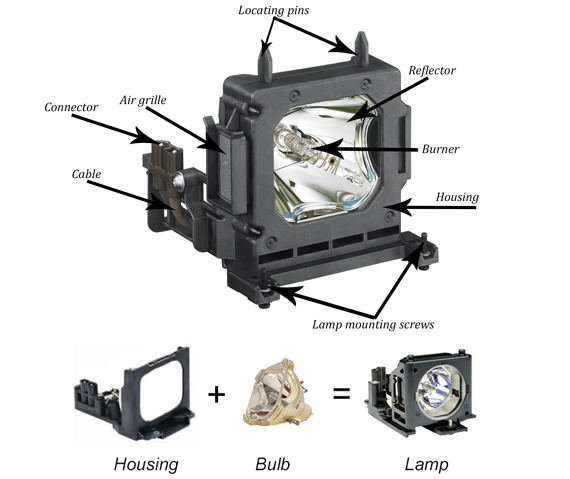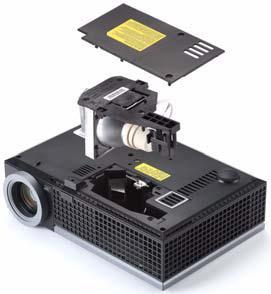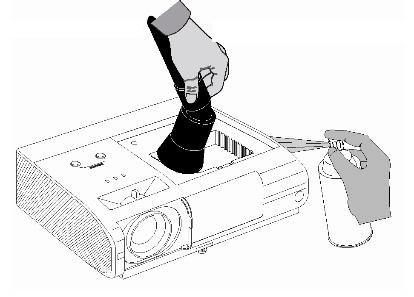
Projector lamps explained
Is it a bulb or is it a lamp? What’s the difference?
It's part terminology and part who uses what word to describe what they require, a bulb or a lamp.
There is a difference.
A projector bulb is exactly that, the bulb. If you purchase a bulb you will need to, very carefully, fit that bulb into the bulb housing. It is quite a technical procedure and not one we recommend.
A projector lamp is the complete unit, bulb + housing. The housing will already have the bulb fitted, so you simply have to remove the old housing from the projector and fit the new one. This method is far more convenient than fitting a bulb only.
Now onto the lamp itself. You will see all manner of terms used to describe the lamp being sold; genuine, genuine original, genuine compatible, original this, original that. It can get quite confusing.
There are just 3 types of lamp you can purchase.
- Original – a.k.a Manufacturers genuine lamp. This means the whole unit, including the bulb and the housing are original, supplied by the manufacturer, such as Epson, NEC, Optoma etc.
- VIVID – a.k.a Genuine Inside. This means all VIVID lamps are fitted with a genuine bulb in a compatible housing.
- TEKLAMPS – a.k.a Compatible. This means a compatible bulb (3rd party) inside a compatible housing (3rd party).
One major shock for customers who need to buy a new lamp is the cost. The technology and engineering that goes into the making of a projector lamp is anything but cheap. Indeed, the machinery required to produce a single lamp can cost the manufacturer hundreds of thousands of pounds, even millions of pounds. This why there are only a handful of major manufacturers producing original projector lamps worldwide.
All projector lamps also have different ignition and running voltages and wattages. These configurations produce different brightness levels (ANSI lumens rates). Therefore, the machines that manufacture projector lamps are complex and expensive to maintain. They must be recalibrated for each specific new lamp setting. There is no short way around this process if the manufacturer wants to produce a high-quality projector lamp.
To help keep costs to a minimum, some projector manufacturers have teamed up and use the same lamp in all their projectors, so the same lamp could fit several models and manufacturers’ projectors.
TEKLAMPS are the perfect choice both for quality and value for money. This means you need not have to pay what can amount to hundreds of pounds more for a genuine lamp without compromising on quality, so peace of mind without the expense.
How to get the most out
of your new lamp

All TEKLAMPS models are manufactured to the highest standards, to ensure the levels of brightness and lamp life are comparable to the genuine lamp. However, depending upon how your projector is handled, or serviced etc., will determine how long your lamp will function for.
Modern projectors will also have a built-in timer to keep track of how long the lamp has been in use. The timer will eventually reach a certain point and display a message on your projector screen, or you may notice, over time, the lamp is not as brilliant as it was when you first installed it. These are warnings indicators that you may have to start considering buying a new lamp.
How to preserve my projector
lamp performance
As mentioned above, there are several things you can do to get the best from your projector and its lamp.

- Never unplug your projector immediately. Most projectors have an internal fan that continues to run even though it’s been switched off. Always allow it to cool down before unplugging. We suggest you leave it plugged in for at least 15 minutes before unplugging.
- Avoid switching the projector on and off repeatedly, this can cause the lamp to fail prematurely.
- Avoid moving the projector when it’s in use, or cooling down after use. Hot lamps are very fragile, any shock movement or vibration may cause the lamp filament to break.
- Clean your projector on a regular basis. Especially the filter, blocked filters can make the lamp overheat and fail far sooner than they should normally. Always ensure the power cord is disconnected before attempting to clean any part of the projector. Use a vacuum cleaner and the use of compressed air to blow out and trapped dust and debris. Change the filter if it cannot be cleaned.
- Use economy mode whenever possible, this can considerably extend the life of the lamp.
- Never obstruct and air vents, and ensure there is sufficient space around the projector for air to enter, and leave, the projector.
- Never touch any part of the bulb with bare hands, wear gloves. Oil and deposits on your hands and fingers can hot spots, which will lead to early lamp failure.
- Test a new lamp for approx. 10-20 hours shortly after purchasing it. Most failures will occur within the first few hours of operation.
Disposing of old projector lamps

Most projector bulbs contain highly pressurised chemicals required to create the very bright light we expect from a projector bulb. One particular chemical used is Mercury, a highly toxic heavy metal.
Please be responsible. You MUST recycle your old projector lamps according to your local council or environmental health department’s guide on how to dispose of products that contain mercury.